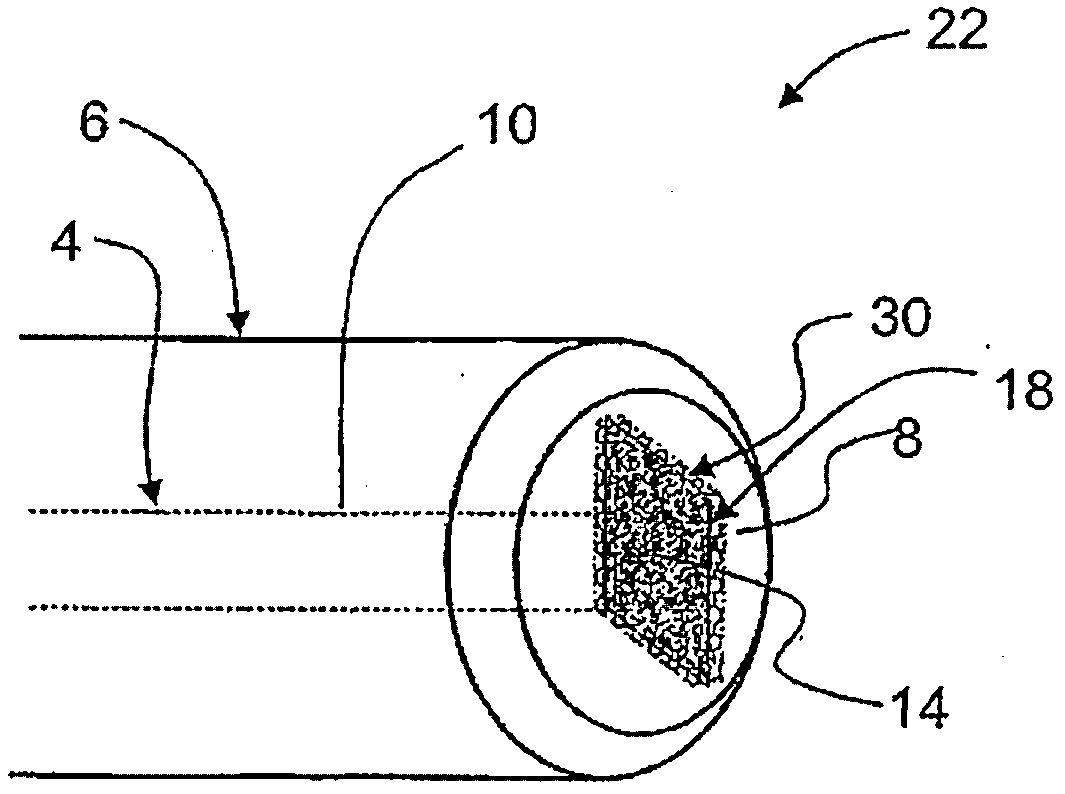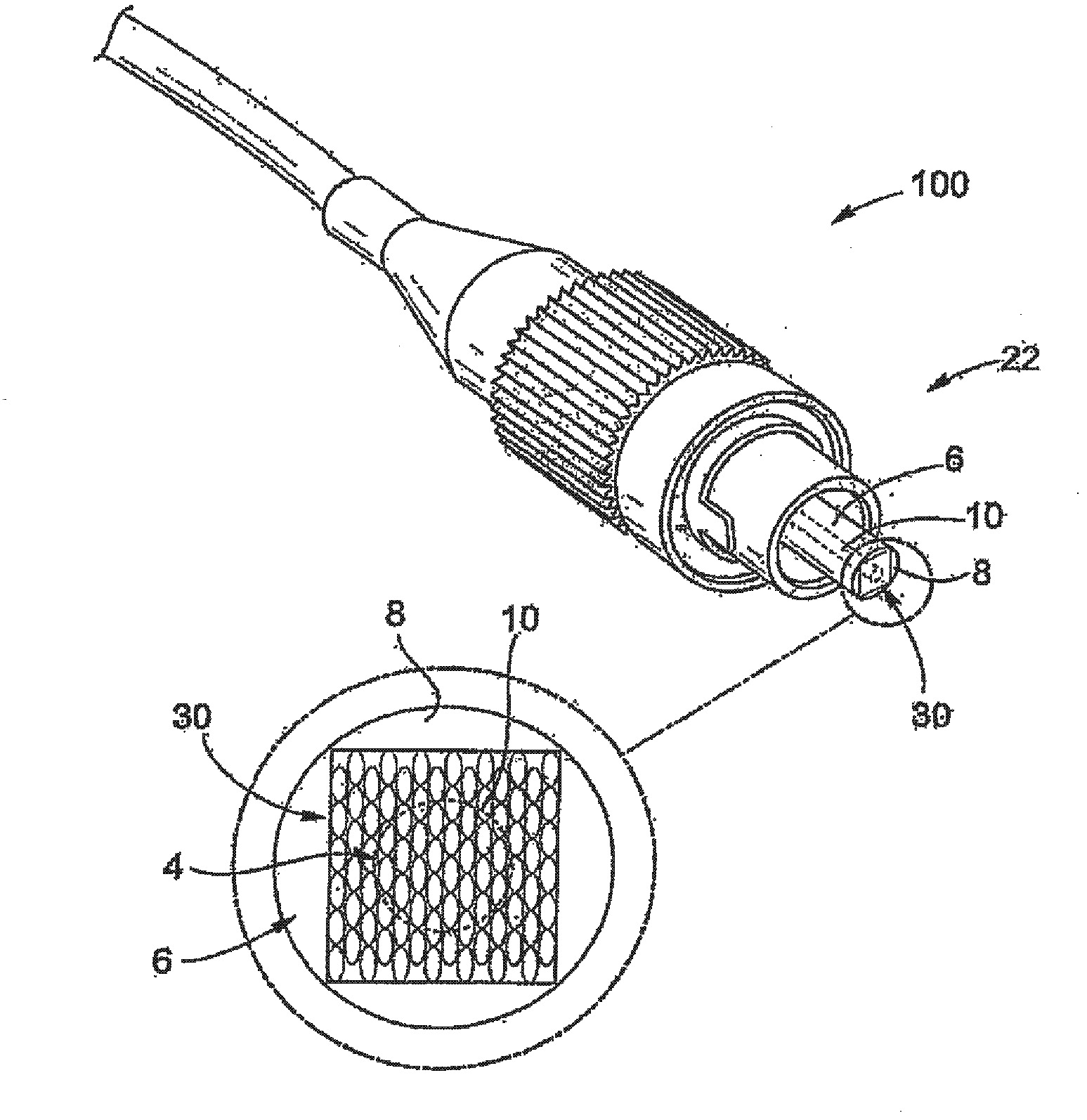Graphene-based saturable absorber devices and methods
A saturable absorption and graphene technology, applied in laser components, instruments, lasers, etc., can solve problems such as poor broadband tunability, inherent problems of precise control of saturable absorbers, high unsaturation loss, etc.
- Summary
- Abstract
- Description
- Claims
- Application Information
AI Technical Summary
Problems solved by technology
Method used
Image
Examples
Embodiment 1
[0036] figure 1 is a perspective view of an optical fiber 10 having a terminal facet 14 onto which graphene-based graphene in the form of a single-layer graphene film 20 (i.e., one atomic layer of graphene or "graphene monolayer") is assembled. A saturable absorber material 18 as a saturable absorber device 22 . figure 1 The saturable absorber device 22 of is suitable for use in mode-locked and Q-switched fiber lasers as described below. figure 1 It is shown that the optical fiber 10 is clamped in the axial pinhole 4 of the ferrule 6 with the end face 8 . The ferrule 6 acts as a fiber holder.
[0037] The graphene monolayer 20 can be obtained by methods such as mechanical exfoliation, epitaxial growth, chemical vapor deposition and chemical processing (solution processing) methods, as well as laser ablation and filtered cathodic arc methods. After the graphene monolayer 20 has been suitably prepared on the substrate, the monolayer is removed as a graphene film and transferr...
Embodiment 2
[0043] figure 2 and figure 1 Similarly, is a perspective view of an optical fiber 10 having a graphene-based saturable fiber in the form of a multilayer graphene film 30 (i.e., graphene polyatomic layers or "graphene multilayers") assembled on the fiber end facet 14. The absorber material 18 serves as a saturable absorber device 22 . figure 2 The saturable absorber device 22 is fabricated for use in mode-locked and Q-switched fiber lasers as described below.
[0044] image 3 Is a photograph of a fiber pigtail 100 with a ferrule 6 clamping an optical fiber 10 and a multilayer graphene film 30 on the end face 8 covering the pinhole 4 and the fiber end facet 14 . A fiber pigtail 100 is inserted into a fiber laser to generate mode-locked or Q-switched pulses, as described below.
[0045] Figure 4 is a magnified optical image of the end face of fiber pigtail 100 showing graphene-based saturable absorber material 18 in the form of multilayer graphene 30 covering pinhole 4 a...
Embodiment 3
[0051] Figure 5 and figure 1 Similarly, is a perspective view of an optical fiber 10 having a graphene-based saturable absorber material 18 in the form of a graphene film 40 . The graphene film 40 is formed from a single layer graphene sheet 42 assembled on the fiber end facet 14 thereby forming the saturable absorber device 22 . Figure 5 The saturable absorber device 22 of is suitable for use in mode-locked and Q-switched fiber lasers as described below.
[0052] In one example, single-layer graphene sheets 42 have small dimensions, eg, less than 10 μm. In one example, a graphene sheet 42 is assembled onto the end facet of a fiber pigtail as a graphene film 40 covering the pinhole 4, and the pigtail 100 is inserted into a fiber laser to generate mode-locked or Q-switched pulses. In one example, small-scale graphene sheets 42 are obtained by solution processing routes or by post-processing of single-layer graphene on a substrate. Post-processing methods include, but are ...
PUM
 Login to View More
Login to View More Abstract
Description
Claims
Application Information
 Login to View More
Login to View More - R&D
- Intellectual Property
- Life Sciences
- Materials
- Tech Scout
- Unparalleled Data Quality
- Higher Quality Content
- 60% Fewer Hallucinations
Browse by: Latest US Patents, China's latest patents, Technical Efficacy Thesaurus, Application Domain, Technology Topic, Popular Technical Reports.
© 2025 PatSnap. All rights reserved.Legal|Privacy policy|Modern Slavery Act Transparency Statement|Sitemap|About US| Contact US: help@patsnap.com



